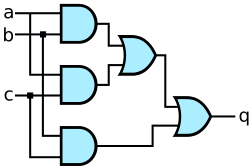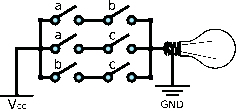From WikiChip
Difference between revisions of "majority gate"
| Line 17: | Line 17: | ||
However the naive implementation will result in up to 30 transistors. Since <math>\text{MAJ}(a, b, c) = \overline{\overline{\text{MAJ}(a, b, c)}}</math>, we can defined as <math>\text{MAJ}(a, b, c) = \overline{\overline{(a \land b) \lor (a \land c) \lor (b \land c)}}</math> and that can be implemented using a single [[AOI|AOI222]] which is defined as <math>\text{AOI222}(a, b, c, d, e, f) = \overline{(a \land b) \lor (c \land d) \lor (e \land f)}</math> - i.e. <math>\text{MAJ}(a, b, c) = \overline{AOI222(a, b, c, a, b, c)}</math>. It can also be implemented using a [[OAI|OAI222]] gate the very same way. Since <math>\text{OAI222}(a, b, c, d, e, f) = \overline{(a \lor b) \land (c \lor d) \land (e \lor f)}</math>, then <math>\text{MAJ}(a, b, c) = \overline{OAI222(a, b, c, a, b, c)}</math> | However the naive implementation will result in up to 30 transistors. Since <math>\text{MAJ}(a, b, c) = \overline{\overline{\text{MAJ}(a, b, c)}}</math>, we can defined as <math>\text{MAJ}(a, b, c) = \overline{\overline{(a \land b) \lor (a \land c) \lor (b \land c)}}</math> and that can be implemented using a single [[AOI|AOI222]] which is defined as <math>\text{AOI222}(a, b, c, d, e, f) = \overline{(a \land b) \lor (c \land d) \lor (e \land f)}</math> - i.e. <math>\text{MAJ}(a, b, c) = \overline{AOI222(a, b, c, a, b, c)}</math>. It can also be implemented using a [[OAI|OAI222]] gate the very same way. Since <math>\text{OAI222}(a, b, c, d, e, f) = \overline{(a \lor b) \land (c \lor d) \land (e \lor f)}</math>, then <math>\text{MAJ}(a, b, c) = \overline{OAI222(a, b, c, a, b, c)}</math> | ||
[[File:maj gate (cmos).svg|left|200px]] | [[File:maj gate (cmos).svg|left|200px]] | ||
| + | {{clear}} | ||
| + | == MAJ5 == | ||
| + | {{empty section}} | ||
| + | |||
| + | == See also == | ||
| + | * [[logic gates]] | ||
| + | * [[compound logic gates]] | ||
Revision as of 15:47, 25 November 2015
| MAJ Gate | ||||||||||||||||||||||||||||||||||||||||||||
| Typical Symbol | ||||||||||||||||||||||||||||||||||||||||||||
| Functional | ||||||||||||||||||||||||||||||||||||||||||||
| Truth Table | ||||||||||||||||||||||||||||||||||||||||||||
| ||||||||||||||||||||||||||||||||||||||||||||
| ||||||||||||||||||||||||||||||||||||||||||||
| ||||||||||||||||||||||||||||||||||||||||||||
The majority gate (MAJ gate) is a logic gate that implements the majority function - a device that outputs a HIGH when the majority of its inputs are HIGH, otherwise it outputs a LOW.
Contents
Applications
| This section is empty; you can help add the missing info by editing this page. |
MAJ3
 A 3-input MAJ gate (MAJ3) can be implemented as .
A 3-input MAJ gate (MAJ3) can be implemented as .
CMOS
However the naive implementation will result in up to 30 transistors. Since , we can defined as and that can be implemented using a single AOI222 which is defined as - i.e. . It can also be implemented using a OAI222 gate the very same way. Since , then
MAJ5
| This section is empty; you can help add the missing info by editing this page. |


